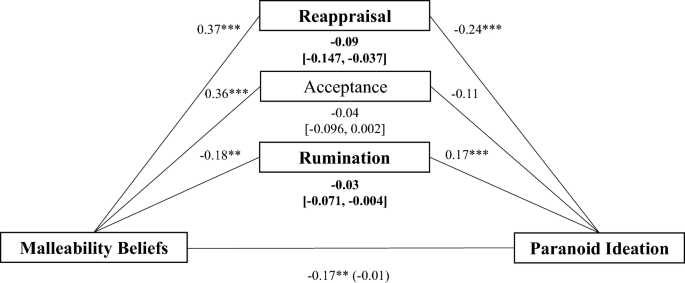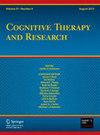Believing in Change Matters! The Role of Emotion Malleability Beliefs in Emotion Regulation and Paranoid Ideation
IF 2
3区 心理学
Q2 PSYCHOLOGY, CLINICAL
引用次数: 0
Abstract
Abstract Purpose Beliefs that emotions can be changed (i.e., malleability beliefs) are relevant to emotion regulation. Emotion regulation plays a crucial role in severe mental health symptoms, such as paranoid delusions, but it remains unknown to which extent malleability beliefs contribute to a dysfunctional pattern of emotion regulation in individuals experiencing paranoid ideation. Therefore, we investigated whether malleability beliefs are associated with paranoid ideation and whether emotion regulation accounts for this association. Methods We conducted a cross-sectional assessment in a sample of individuals with psychotic disorders ( n = 50) and a community sample ( n = 218) and collected self-report data on malleability beliefs, the use of emotion regulation strategies (reappraisal, acceptance, rumination, expressive suppression, experience suppression), and paranoid ideation. Results Multivariate regressions showed that greater beliefs that emotions are malleable predicted more reappraisal and acceptance in both samples and less rumination in the community sample. Malleability beliefs did not predict the strategies of suppressing an emotion or its expression. In the community sample, but not in the clinical sample, greater beliefs that emotions are malleable were associated with less frequent paranoid ideation and emotion regulation accounted for significant variance in the relationship. Conclusions The findings indicate that malleability beliefs do not contribute to paranoid delusions in individuals with psychotic disorders. However, in individuals with subclinical paranoid ideation, a failure to perceive emotions as malleable could hinder adaptive attempts to regulate emotions leading to increased negative affect and thereby pave the way for paranoid ideation. Malleability beliefs may thus represent a promising target for prevention.

相信改变很重要!情绪可塑性信念在情绪调节和偏执观念中的作用
情绪可改变信念(即可塑性信念)与情绪调节有关。情绪调节在严重的心理健康症状(如偏执妄想)中起着至关重要的作用,但在经历偏执妄想的个体中,可塑性信念在多大程度上导致了情绪调节的功能失调模式尚不清楚。因此,我们调查了可塑性信念是否与偏执观念有关,以及情绪调节是否解释了这种联系。方法对精神障碍患者(50例)和社区样本(218例)进行横断面评估,收集自我报告的可塑性信念、情绪调节策略(重新评价、接受、反刍、表达抑制、经验抑制)和偏执观念的使用数据。结果多变量回归表明,相信情绪具有可塑性的人在两类样本中都有更多的重新评价和接受,而在社区样本中则有更少的反思。可塑性信念并不能预测抑制情绪或表达情绪的策略。在社区样本中,而不是在临床样本中,更大的信念是情绪是可可塑性的,与更少的偏执观念和情绪调节有关,这在关系中占了显著的差异。结论研究结果表明,可塑性信念与精神病患者的偏执妄想无关。然而,在患有亚临床偏执妄想的个体中,未能将情绪视为可塑造的可能会阻碍调节情绪的适应性尝试,从而导致负面影响的增加,从而为偏执妄想铺平道路。因此,可塑性信念可能是预防的一个有希望的目标。
本文章由计算机程序翻译,如有差异,请以英文原文为准。
求助全文
约1分钟内获得全文
求助全文
来源期刊

Cognitive Therapy and Research
PSYCHOLOGY, CLINICAL-
CiteScore
5.30
自引率
0.00%
发文量
52
期刊介绍:
Cognitive Therapy and Research (COTR) focuses on the investigation of cognitive processes in human adaptation and adjustment and cognitive behavioral therapy (CBT). It is an interdisciplinary journal welcoming submissions from diverse areas of psychology, including cognitive, clinical, developmental, experimental, personality, social, learning, affective neuroscience, emotion research, therapy mechanism, and pharmacotherapy.
 求助内容:
求助内容: 应助结果提醒方式:
应助结果提醒方式:


